
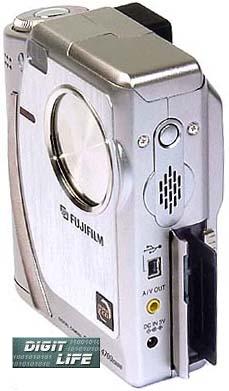
Perfect camera, one of the best in the compact
camera class. It's pleasant both to look at and to hold in the hands,
not in vain the cameras of such design are produced not only by
Fuji but also by Leica. (Today's hero has its own sister LEICA
DIGILUX 4.3)
This camera was announced 4 Mpixel (it shows the
number of pixels of in an image), though the matrix of this camera
has only 2.4 Mpixel as for sensing elements.

Imagine a simple chess-board. In a usual matrix
sensing elements are located on each square of this chess-board,
and in our case they are situated i.e. only on black squares. In
order to record an image in a standard file, you'll have to write
something in white squares or you are to think out your own format.
Kodak has already faced such problems in cameras of DC120 type.
There, when recording information in order not to take place purposeless
on the memory cards they used KDC format, which when recording on
the computer was converted into standard one. Fuji has taken a way
of recording non-standard image into a standard file. Of course
it's not economic usage of the space on the memory card but it's
quite universal.
A frame of 2400 X 1800 pixels in size due to measurements
in 2400000 pixels. The shots of the resolution chart showed that
the camera has 1300 vertical grooves per frame, what is similar
to other 2X Mpixel brothers, and it lags behind 3-Mpixel ones. But
all pixels turn to be in similar situation, and resolution doesn't
practically depend on a channel. However all this concerns resolution
of monochrome imagery. Color image of all cameras of this price
range can be obtained by interpolation on the neighboring pixels.

Spectral characteristics of this camera don't differ
significantly from others, but we should notice that we observed
sensitivity of the blue channel to the long-wave spectrum part.
It's possible that in front of the matrix there is no a filter that
cuts off infrared spectrum component. Though, this effect can be
explained differently.
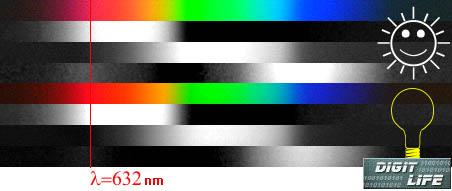
The idea, that such positioning of sensing elements
allows increasing sensitivity, failed after we had tested this camera.
At the rated sensitivity of the matrix 200, 400, 800 ISO a comparison
of exposure and aperture values with the values of an exposure meter
showed the sensitivity 4 times less. We carried out measurements
on brightness of the sky and a gray screen alight with 500 W lamp
with a reflector (2 m away). ISO=200
| Camera |
FujiFilm FinePix 4700
|
Canon EOS 50 |
 |
Exposure |
Aperture |
Exposure |
Aperture |
| Screen alight with a
lamp |
1/45
|
F:2,8
|
1/45
|
F:5,6
|
| Sky |
1/140
|
F:7
|
1/500
|
F:8
|
So, the real sensitivity of this camera isn't a
bit different from an average value.
800 ISO sensitivity causes a noticeable shift in
the color balance. Below are fragments of the photo of a white screen
alight with a halogen lamp. The white balance was forcibly set in
the position "Incandescent lamp".

I think that marketing tricks of this company are
wasted labor. This camera is intended to serve as record book. Constant
shooting doesn't live here. It's perfect as a photo record book:
it's equipped with 3x zoom lens system, option to record clips with
sound, indication of singled out parameters. It means this camera
doesn't make you think - it just informs you of exposure and aperture
for the upcoming shooting, and let's you correct it in the menu
Exposure Correction. Besides, there is manual focusing, sensitivity
setting, white balance, exposure measuring method, screen brightness
adjustment etc., etc. That is, there are enough options to fix any
event.
Video shooting is a bit damaged with impossibility
to use an optical zoom (only a digital one). Besides, the focal
length is set for minimum, that's why an image obtained had too
minute details.
This small camera is fed with two AA rechargeable
batteries. The matter is that it takes the same energy as the others
but voltage is two times smaller. It means that it must take two
times increased current.
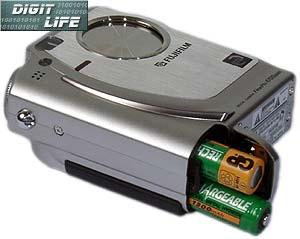
The table shows currents in different modes:
| Mode |
Current, A |
| Shooting. The screen contains
only information |
1,06
|
| Shooting. The screen serves
as a viewfinder |
1,56
|
| Shooting. The screen serves
as a viewfinder + lens engine |
1,77
|
| Playback |
1,09
|
Interestingly that when the camera displays just
information without viewfinder functions it takes much more energy.
In general, handling is quite pleasant: you have
a round LC indicator which demonstrates joystick functions in different
modes.
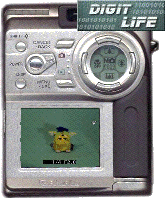
Unfortunately, an optical viewfinder disappointed
us a bit as it lacks for option of dioptre setting. However, lens
optical characteristics are very close to that of a human eye, so
it allows shooting right through eyelens, with an image taking almost
the whole area of a frame (usually it's necessary to choose a special
lenseye for a camera). As an example you can see several shots made
with different microscopes.
The simplest microscope "NATURALIST" gives decent
quality:


And with an ancient microscope from Carl Zeiss
the quality is just perfect:
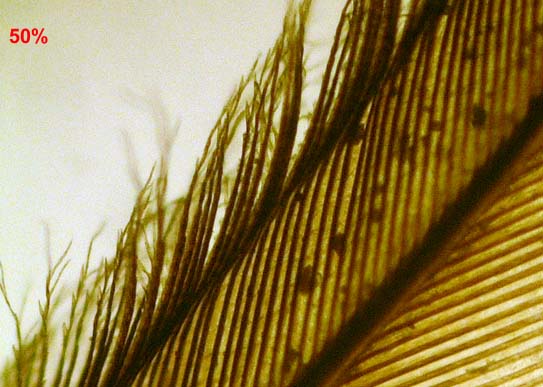
Fragment diminished two times as comparing with an
original. A miniature of the whole frame and shooting parameters
can be seen on an illustration devoted to the program Exif Viewer
which goes further.
The camera is supplied with a program Exif Viewer.
Interestingly that it contains data fields received with the help
of GPS.
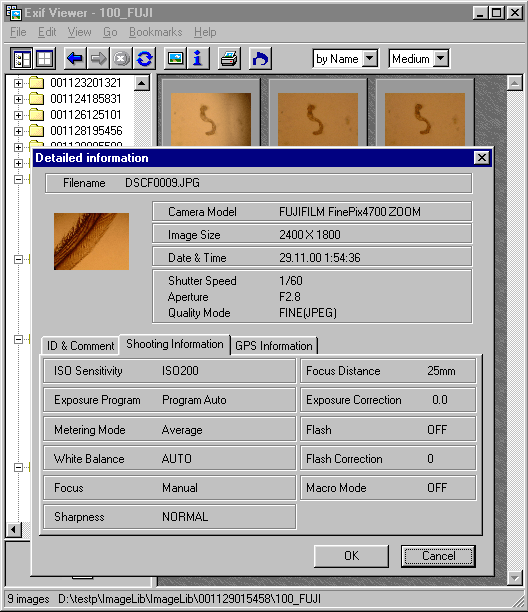
Shot fragment

Technical characteristics
| Sensing element |
CCD; 2.4 million pixels;
GRGB |
| Matrix size |
1/1,7" |
| Frame size |
2400X1800 (interpolated),
1280X960, 640X480 pixels |
| File format |
JPEG(Exif) |
| Sensitivity |
ISO 200, 400, 800 |
| Memory card |
Smart Media 16 MBytes |
| Lens focal length |
8,3 - 24,9 mm (36-108
mm in 35mm equivalent) |
| Lens aperture |
F:2,8 - F:4,5 |
| Exposure |
3 – 1/2000 s |
| Aperture |
F:2.8- F:7,0; F4.5 –
F:10,8 |
| Auto focus |
80 cm – infinity |
| Macro mode |
20 cm – 80 cm |
| Exposure compensation |
-1.5 EV to +1.5 EV with
1/3 increment |
| White balance |
7 modes |
| I/O |
USB, Video NTSC or PAL |
| Flash |
Auto/manual |
| Power supply |
2 AA batteries |
| Size |
78X97.5X32.9 mm |
| Weight |
280 g |
Write a comment below. No registration needed!













